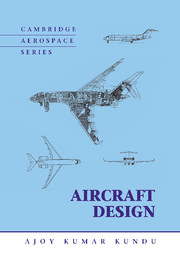Book contents
- Frontmatter
- Contents
- List of Symbols and Abbreviations
- Preface
- Road Map of the Book
- 1 Introduction
- 2 Methodology to Aircraft Design, Market Survey, and Airworthiness
- 3 Aerodynamic Considerations
- 4 Aircraft Classification, Statistics, and Choices for Configuration
- 5 Aircraft Load
- 6 Configuring Aircraft
- 7 Undercarriage
- 8 Aircraft Weight and Center of Gravity Estimation
- 9 Aircraft Drag
- 10 Aircraft Power Plant and Integration
- 11 Aircraft Sizing, Engine Matching, and Variant Derivative
- 12 Stability Considerations Affecting Aircraft Configuration
- 13 Aircraft Performance
- 14 Computational Fluid Dynamics
- 15 Miscellaneous Design Considerations
- 16 Aircraft Cost Considerations
- 17 Aircraft Manufacturing Considerations
- Appendix A Conversion
- Appendix B International Standard Atmosphere
- Appendix C Aerofoils
- Appendix D Case Studies
- Appendix E Tire Data
- References
- Index
14 - Computational Fluid Dynamics
Published online by Cambridge University Press: 05 June 2012
- Frontmatter
- Contents
- List of Symbols and Abbreviations
- Preface
- Road Map of the Book
- 1 Introduction
- 2 Methodology to Aircraft Design, Market Survey, and Airworthiness
- 3 Aerodynamic Considerations
- 4 Aircraft Classification, Statistics, and Choices for Configuration
- 5 Aircraft Load
- 6 Configuring Aircraft
- 7 Undercarriage
- 8 Aircraft Weight and Center of Gravity Estimation
- 9 Aircraft Drag
- 10 Aircraft Power Plant and Integration
- 11 Aircraft Sizing, Engine Matching, and Variant Derivative
- 12 Stability Considerations Affecting Aircraft Configuration
- 13 Aircraft Performance
- 14 Computational Fluid Dynamics
- 15 Miscellaneous Design Considerations
- 16 Aircraft Cost Considerations
- 17 Aircraft Manufacturing Considerations
- Appendix A Conversion
- Appendix B International Standard Atmosphere
- Appendix C Aerofoils
- Appendix D Case Studies
- Appendix E Tire Data
- References
- Index
Summary
Overview
Computational fluid dynamics (CFD) is a numerical tool for solving equations of fluid mechanics. CFD is a relatively recent development that has become an indispensable tool in the last two decades. It was developed originally for aeronautical uses but now pervades all disciplines involving flow phenomena, such as medical, natural sciences, and engineering applications. The built-in codes of the CFD software are algorithms of numerical solutions for the fluid-mechanics equations. Flow fields that were previously difficult to solve by analytical means – and, in some situations, impossible – are now accessible by means of CFD.
Today, the aircraft industry uses CFD during the conceptual study phase. There are limitations in obtaining accurate results, but research continues in academic and industrial circles to improve prediction. This chapter aims to familiarize newly initiated readers with the scope of CFD in configuring aircraft geometry (those already exposed to the subject may skip this chapter). This is not a book about CFD; therefore, this chapter does not present a rigorous mathematical approach but rather an overview.
CFD is a subject that requires considerable knowledge in fluid mechanics and mathematics. CFD is introduced late in undergraduate studies, when students have mastered the prerequisites. Commercial CFD tools are menu-driven and it is possible to quickly become proficient, but interpreting the results thus obtained requires considerable experience in the subject.
An accurate 3D model of an aircraft in CAD significantly reduces preprocessing time.
- Type
- Chapter
- Information
- Aircraft Design , pp. 464 - 475Publisher: Cambridge University PressPrint publication year: 2010



